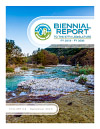Chapter 1: Agency Highlights (FY2019-2020)
This chapter summarizes the agency's recent challenges and other ongoing agency programs. (Biennial Report to the 87th Legislature, FY2019-FY2020)
As the state's environmental agency, the Texas Commission on Environmental Quality is engaged with every region of the state. Agency employees in the Austin headquarters and 16 field offices are immersed every day in a wide spectrum of issues related to air and water quality, water supply, and waste management. The agency is also active in promoting pollution prevention and educating Texans about protecting the environment.
During the fiscal years of 2019 and 2020, TCEQ found itself intensely monitoring air quality across the state in the aftermath of several chemical fires, as well as adjusting to a remote and safe approach to maintaining health and public safety with the onset of the COVID-19 pandemic.
The agency had leadership changes, including a new commissioner, and two new deputy executive directors.
All these activities occur against a backdrop of the state's fast-growing population and expanding economy. TCEQ has responded with initiatives adapted to changing times and challenges, while continuing its dedication to protecting public health and the state's natural resources.
Leadership Changes
New Commissioner
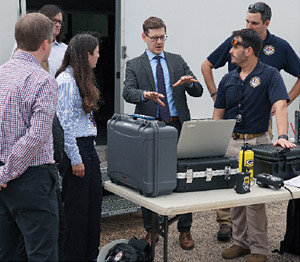
On Sept. 16, 2019, Gov. Greg Abbott selected Bobby Janecka to serve as a TCEQ commissioner alongside incumbents Emily Lindley and Chairman Jon Niermann. After serving as a section manager in TCEQ's Radioactive Materials Division for five years, Janecka spent the year leading up to his appointment as a policy adviser to Texas Gov. Greg Abbott, and as the state's liaison to the Nuclear Regulatory Commission since May 2019. Before that, he gained a bulk of his governmental experience serving as an intergovernmental relations specialist for the Texas Comptroller of Public Accounts and as a legislative aide to two state representatives.
New Executive Director
On the cusp of the new biennium, Toby Baker was appointed executive director of TCEQ on Aug. 20, 2018. Prior to his move to executive director, Baker served as a TCEQ commissioner for six years. In addition to his role as executive director, Baker also serves as Governor Abbott's appointee to the Gulf Coast Ecosystem Restoration Council, represents Texas as the chair on the Gulf of Mexico Alliance Management Team, and serves on the Coastal Land Advisory Board.
New Deputy Executive Directors
On Apr. 1, 2020, L'Oreal Stepney and Ramiro Garcia, Jr. were selected as deputy executive directors of TCEQ.
Stepney started with TCEQ in 1992 and worked eight years in the Air Permitting Division. Initially a new source review permit writer, she later became a team leader and technical specialist responsible for the development and implementation of many aspects of the Title V permitting program. In 2000, Stepney moved to the agency's water programs and became a section manager for the Wastewater Permitting Section before being promoted to division director in 2003 for the Water Quality Division. She was later appointed to assistant deputy director of the Office of Permitting and Registration, where her focus was on the water supply and water quality programs. When the Office of Water was created in 2009, Stepney was named deputy director, a post she served in until her appointment to deputy executive director.
Garcia joined TCEQ in October 1994 in the Petroleum Storage Tank (PST) Division, where he had previously worked as a Mickey Leland environmental intern during the summer of 1993. He became a team leader in the PST Division in 1996. In 2000, Garcia transferred to the Houston Region Office where he was an investigator and subsequently a team leader until 2005, when he transferred back to the TCEQ central office. He worked in the Field Operations Air Support Section, becoming the section manager in 2007. In 2008, Garcia became the area director for the TCEQ Border/South Central Area, comprised of regional offices in Austin, San Antonio, El Paso, Laredo, and Harlingen. In 2012, Garcia became the deputy director of the Office of Compliance and Enforcement, a post he served in until his appointment to deputy executive director.
Emergency Response
During emergency situations, TCEQ provides strategic state assets to support state and local operations and assists its regulated facilities in continuing to provide essential services to the public.
ITC Fire
The incident at Intercontinental Terminals Company (ITC) in Deer Park began on March 17, 2019. TCEQ began conducting air and water quality monitoring in the surrounding area as soon as conditions allowed.

Water Quality Monitoring
TCEQ assessed surface water quality data collected by our staff, contractors, the U.S. Environmental Protection Agency (EPA), and ITC and posted sample results on the agency's website.
Water samples were collected in the Houston Ship Channel and in Galveston Bay to identify any potential surface water quality impacts from releases associated with the ongoing ITC incident. To better determine the potential extent of impact, additional surface water quality sampling was conducted by TCEQ at various beach locations.
Sampling results were posted as the data was analyzed through June 13, 2019.
Air Quality Monitoring
TCEQ's ambient air monitoring network routinely collects data from stationary monitors throughout the state, including the Houston area. On March 18, 2020, two additional air monitoring stations (monitoring vans) were strategically deployed in coordination with the Unified Command in response to the ITC fire.
TCEQ also assigned environmental investigators and contractors to conduct 24-hour hand-held monitoring and enlisted EPA's Trace Atmospheric Gas Analyzer bus and Atmospheric Spectral Photometric Environmental Collection Technology airplane to provide air monitoring and to conduct monitoring flights over the area.
The handheld monitoring equipment provides instantaneous readings for various compounds, including volatile organic compounds (VOCs), benzene, lower explosive limit, hydrogen sulfide, carbon monoxide, sulfur dioxide, and radiation.
All of the air monitoring data collected during the ITC event was evaluated and posted on TCEQ's website. Data continued to be collected and posted until Aug. 30, 2019, after tank demolition was completed. Data from TCEQ's ambient air monitoring network continues to be available on TCEQ's GeoTAM web application.
On Mar. 22, 2019, on behalf of TCEQ, the Texas Attorney General filed a lawsuit against ITC for violations of the Texas Clean Air Act. On Mar. 27, 2019, the lawsuit was amended to include violations of the Texas Solid Waste Disposal Act and the Texas Water Code.
Waste Management
TCEQ reviewed multiple plans for characterization of waste during and after the incident concluded. The ITC fire resulted in contaminated containment booms, decontamination waste, and debris for which TCEQ provided guidance on appropriate classification, transportation, and final disposal.
TPC Port Neches Plant Fire
For two months, TCEQ responded to the incident at the Texas Petrochemicals (TPC) Group Port Neches Operations that began on Nov. 27, 2019. Regional staff and TCEQ contractors conducted 24-hour handheld air monitoring around the incident and provided that information to Unified Command.
Throughout the incident, TCEQ provided continuous updates to the public through social media and via the homepage of TCEQ's website.
As of Jan. 17, 2020, Beaumont regional staff conducted a visible emissions and odor survey in the neighborhood surrounding TPC. No visible emissions, significant readings, or odors were documented by the investigators.
Efforts to contain the fire were also monitored by TCEQ, and water runoff resulting from firefighting was contained onsite and treated prior to discharge. TCEQ regional staff evaluated nearby water bodies for impacts.
On Feb. 21, 2020, on behalf of TCEQ, the Texas Attorney General filed a lawsuit against TPC Group, Inc. and TPC Group, LLC for violations of the Texas Clean Air Act and the Texas Water Code. The lawsuit also includes claims that TPC Group caused numerous violations of TCEQ's air quality program from January 2018 through September 2019.
Tule Lake Channel Fire
TCEQ began conducting air quality monitoring and water sampling in Corpus Christi following a barge collision with a pipeline early the morning of Aug. 21, 2020. The collision caused an explosion and fire in Tule Lake Channel near Nueces Bay.
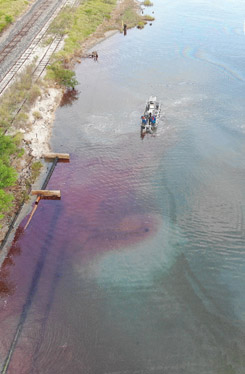
Agency personnel coordinated with local first responders, local officials, and state and federal partners, including the Texas General Land Office and U.S. Coast Guard, to assist with emergency response to the fire.
TCEQ and its contractors conducted off-site air monitoring in the surrounding area and mobilized TCEQ's Rapid Assessment Monitoring Van to support the agency's air monitoring efforts. The Rapid Assessment Monitoring Van continuously takes air samples while driving and reports the data in real time to the monitoring team.
Hurricane Laura
While Hurricane Laura avoided the worst-case scenario predictions for most of Texas, Hurricane Harvey taught us valuable lessons about hurricane preparedness.
In preparation for Hurricane Laura, TCEQ stood ready to enact emergency response plans for air quality monitoring, safe drinking water, critical water infrastructure, wastewater and sewage, and flood water impacts.
TCEQ's mobile monitoring assets and the Emergency Management Support Team, along with assistance from the Texas National Guard 6th Civil Support Team, were deployed to provide support to the storm-affected areas in Southeast Texas. A TCEQ Disaster Response Strike Team from the western regions was also at the ready to assist with response efforts.
TCEQ's Critical Infrastructure Division monitored the projected path of the hurricane and stood ready to assist dam owners for potential damage or failures. State Superfund sites in the projected path of Hurricane Laura were secured and there were no major impacts noted.
To ensure safe drinking water before, during, and after the hurricane, TCEQ's Office of Water contacted public water system operators to provide hurricane preparedness guidance, instructions on issuing a boil water notice, and resources for assistance. In the aftermath of the hurricane, TCEQ conducted assessments of 171 drinking water systems in the seven-county area directly impacted by the storm. The agency also assessed 58 wastewater systems.
TCEQ approved several temporary debris-management sites to handle the cleanup of Laura into fiscal 2021. To ensure these sites are being properly managed, TCEQ Beaumont region conducts weekly investigations of the sites.

Environmental Restoration
While TCEQ strives to protect air, land, and water across the state of Texas, it is impossible to prevent all harm to the environment. Sometimes the best route is environmental restoration, which takes a polluted or illegal-use space and restores it to environmental compliance. The illegal or improper disposal of scrap tires is an especially prevalent problem in Texas, and TCEQ-supported Supplemental Environmental Projects helped remediate a significant amount of land in 2019 and 2020 for use.
Supplemental Environmental Projects (SEP)
When a facility or plant is found to be in violation of an environmental law, they are often fined by TCEQ. However, state law allows a business to put a portion of the fine to work closer to home or across the state, improving the environment. This option is a SEP, which has a direct and measurable environmental benefit in communities across Texas.
SEPs have a direct impact on the ecosystem. In Van Zandt County, where agriculture is the mainstay, crews worked to remove 15,000 tires that were illegally dumped in the Jackson community. That land has now returned to agricultural use.
At the Armand Bayou Nature Center, volunteers and staff worked to protect, restore, and enhance 2,500 acres of unique and vanishing ecosystems in southeast Harris County: coastal tallgrass prairie, forested wetland, and tidal marsh stream.
Across the state, 3.58 tons of household hazardous waste and 16.89 tons of electronic waste were properly disposed of and 61.01 tons of trash was cleaned up. These are all examples of SEP projects that TCEQ supports.
Scrap Tire Remediation
When used tires are not disposed of properly, they create breeding grounds for disease-carrying mosquitos and contribute to the problem of illegal tire dumping.
Another problem is the potential for fires. Besides being difficult to extinguish, the combustion of vulcanized rubber releases toxins into the air and produces nuisance odors.
In 2019, 14.4 million scrap tires were spread across the state at 97 unauthorized scrap tire sites. Successful cleanups reduced that number to 11.8 million tires in 2020.
In Texas, an increasing number of used and scrap tires are now being turned into fuel or used for other beneficial purposes. TCEQ data shows that the number of tires being diverted from landfills has gone from 75% in 2015 to 79% in 2019— with 35.6 million tires recycled or repurposed in 2019.
Of the scrap or used tires collected, the main end-uses include tire-derived fuel sources, crumb rubber production, land reclamation projects, and other beneficial or recycling uses.
The increase in tires recycled can be attributed to a combination of factors, such as proper handling of tires and better reporting. Collaborative effort between government and private entities is an additional factor that contributed to successful cleanups this biennium.
Gatesville Tire Site Cleanup
For 17 years, the "Gatesville tire site" served as a dumping ground for used and discarded tires. During that time, a staggering 268,000 tires accumulated on the 40-acre property.
Starting in 2000, TCEQ conducted numerous investigations into the site, leading to multiple enforcement actions, including fines as well as orders directing the responsible party to either clean up the site or to properly manage the tires.
After TCEQ exhausted all administrative enforcement actions, the case was elevated to the state Attorney General's office for civil enforcement. Meanwhile, the property owner abandoned the land, and in 2005, defaulted on the property loan. Ownership of the land reverted to the Texas General Land Office (GLO).
GLO immediately began the process of securing grants and allocating state funding for the cleanup and remediation of the site. TCEQ and GLO worked together to find ways to clean and return the site to its natural condition.
One problem, however, was that the tires were classified as waste. Designating the rubber for beneficial use would require clarification of EPA's Non-Hazardous Secondary Materials Rule. This rule effectively prevented the discarded tires at the site from being used for fuel in things like cement kilns.
TCEQ and GLO worked with EPA to obtain approval to have the tires from the Gatesville site, and others like it, classified as an alternative fuel source. (Prior to this clarification, tires that were considered "discarded" could not be used as tire-derived fuel in cement kilns unless those kilns met additional standards meant for commercial and industrial solid waste incineration units.)
EPA's clarification brought the potential for further recycling. Even more tires—approximately 4.4 million throughout the state—can potentially be recycled thanks to this action.
From 2018 to 2019, GLO continuously worked with TCEQ throughout the cleanup phases to ensure proper remediation of the site. TCEQ provided technical review and oversight of the remediation and disposal, and soon thousands of scrap tires were removed from the site each day, ultimately resulting in the recycling or disposal of 268,000 tires.
The partnership between TCEQ and GLO allowed TCEQ to focus on the cleanup goal, not on continued investigation and enforcement, by bringing together state and federal agencies to pursue new and less costly scrap tire solutions.
In October 2019, TCEQ personnel performed a final closure inspection and determined that the site had, indeed, been properly remediated. Overall, TCEQ investigators conducted a total of 10 site inspections throughout the span of the cleanup to monitor its progress. More than $1.5 million in state funding supported the comprehensive cleanup efforts and improvements to site infrastructure, and the completely transformed site was listed for sale in the Fall of 2019.
The cooperation and collaboration on this singular goal for the Gatesville site between TCEQ, GLO, and EPA was unprecedented, and would not have been possible without the dogged behind-the-scenes work of TCEQ regional and support staff.

Vista International Cleanup
In Hutchins, Texas, TCEQ and the Office of the Attorney General of Texas worked together with a new property owner to coordinate a cleanup of an abandoned tire site. Along with authorized transporters, processors, and end users, TCEQ staff worked to assist in the removal of approximately 2.5 million scrap tires and tire pieces from the property in 2019 and 2020. This removal project is ongoing.
Response to COVID-19 Pandemic
TCEQ is committed to protecting public health and the environment for all Texans, even during a pandemic.
After the rapid series of directives were issued to curb the spread of COVID-19 in Texas, a record number of agency staff were able to convert their roles to teleworking positions, on very short notice.

For some positions, teleworking was not a feasible option. Investigations and field operations in response to high-priority field events, such as citizens' environmental concerns or emergency response situations, still had to be carried out. Meanwhile, limited in-office staff members from various offices around Texas began working in shifts to package and prepare personal protective equipment and sanitizing products to be used by staff whose jobs still take them out into the field.
In the field, clean hands and equipment became a bigger priority. Vehicles were disinfected with wipes after use. While some investigations and emergency response events require some interaction with each other, as well as with personnel from other agencies, staff found ways to limit their exposure to the public while continuing to serve them. Procedures were developed in response to the pandemic so staff could safely conduct water quality monitoring activities in the field.
Many investigators added signs to their work trucks to let people know they were socially distancing themselves for everyone's safety, with phone numbers listed to safely stay in contact.
Staff in TCEQ's air labs devised a schedule so that staff could work in shifts throughout the week as needed. Dedicated workspaces were created for each air analyst where possible, and equipment was cleaned frequently. Staff now wear additional safety equipment when working in the lab. This allows them to keep the lab running while still maintaining social distancing.
Staff throughout the agency began using technology to its fullest extent. The Information Resources Division expanded the agency's remote information technology (IT) capabilities in record time, and was able to quickly distribute a large number of laptops and cellphones, assist with the expansion of internet and virtual private network (VPN) capability, and provide remote access to the agency telecom help line—all while managing an unprecedented uptick in the volume of Help Desk support requests.
To help the healthcare community and first responders, the agency donated 500 P95 masks to the Texas Department of Public Safety and another 300 to the Austin Regional Clinic. While TCEQ staff sometimes wear these when responding to environmental events, it was important to ensure the masks went where they were most needed at the time, because staff could use other safety-approved masks in the meantime.
To assist public water systems during the COVID-19 pandemic, TCEQ created a centralized webpage to provide important information and resources to maintain operations through the uncertainties associated with the pandemic. The webpage provides guidance for the continuity of operations, preparing for extended operator absence, technical guidance, how to obtain chemical supplies if shortages occur, and how to obtain emergency approvals.
TCEQ is in close contact with drinking water laboratories and public water system operators to ensure continued operations.

Air Quality Successes
EPA sets National Ambient Air Quality Standards for ozone, carbon monoxide, sulfur dioxide, nitrogen dioxide, coarse and fine particulate matter (PM10 and PM2.5), and lead. Over the past few decades, Texas has made huge strides in improving air quality. Most recently, the successes have centered around improved air monitoring technology and emissions reduction.
Air Monitoring Technology
Air Monitoring Stations for PM2.5 and PM10
TCEQ expanded its network of air monitoring stations by introducing four new stations in Central Texas. One location is in Comal County, one is in Atascosa County, and the other two are in Bexar County.
The stations take measurements of particulate matter in the air, commonly notated as PM2.5 and PM10. Particulate matter is a mix of small particles and liquid droplets and can be created by both natural and manmade causes, including incomplete combustion, smoke from fires, and dust or dirt from unpaved roads or construction activities.
Quarries, sand mines, and their associated aggregate operations are also common sources of particulate matter. TCEQ deployed these particular monitoring stations in response to citizen concerns regarding local air quality in areas of heavy quarry and sand mine activity near residential areas.
The new monitoring stations are positioned in residential areas about one mile downwind of existing quarry or mining operations. Texans can access monitoring data through TCEQ's GeoTAM web application and stay aware of forecasted air quality conditions and their local air quality index by visiting TCEQ's Air Quality Forecast webpage. The forecast is also emailed and tweeted daily to the agency's Twitter feed.
Monitoring Vans
TCEQ further enhanced its air monitoring capabilities thanks to new equipment funded by the Texas Legislature and savings from the agency's 2019 budget.
As sought by TCEQ, the 86th Texas Legislature provided funding to equip three monitoring vans with enhanced technologies that allow for true mobile monitoring—capabilities it did not previously possess—while budget savings allowed for the installation of three new automated gas chromatograph (autoGC) air monitoring stations in the Houston area, and the purchase of new handheld air monitors that can make specific benzene readings.
This new equipment expands TCEQ's ability to rapidly assess air quality, particularly around petrochemical facilities, but it will also help with daily monitoring of ambient conditions, including the Houston ship channel area. Upgrading air monitoring capabilities allows the agency to better respond to natural disasters and emergency response events, which in turn gives local officials valuable time to make the best possible decisions to protect public health.
Funding appropriated by the 86th Legislature was used to upgrade two existing monitoring vans with mass spectrometers that can sample in real-time for a broad target pollutant list, expandable to more than 1,000 compounds, including benzene. Funding also provided for the purchase of a third vehicle with complementary technology capable of conducting rapid assessment surveys for a narrower pollutant list that also includes benzene.
These vehicles can be deployed to any area of the state when there is the need for real-time mobile monitoring, and the data they gather will help with critical situational awareness for local officials and emergency response personnel.
Previously, TCEQ's vans were equipped with instruments capable of collecting data only while stationary and required a time-consuming process to deploy and calibrate. All three vans are now equipped with technologies that allow for analysis of compounds in seconds, making them suitable for in-transit monitoring. In addition, the newest van is equipped to conduct rapid survey assessments, allowing the agency to quickly sample for pollutant hot spots, map air concentrations in an area, and identify locations for sampling over longer durations.

Air Monitoring Stations for VOCs
In response to an agency request, the Legislative Budget Board and Gov. Greg Abbott approved the reallocation of unused 2019 funds to purchase three new autoGC air monitoring stations.
The new autoGC air monitors, capable of continuous measurement of 46 volatile organic compounds, are currently planned for the Pasadena, Manchester, and Channelview communities. Once they are operational, the data from the new monitors will be available in near real-time to the public through TCEQ's website.
Handheld Monitors
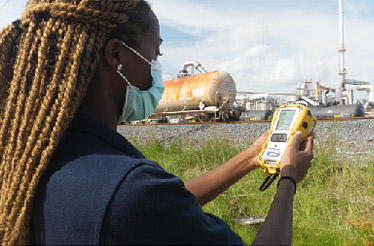
Finally, the agency was able to purchase 15 hand-held air monitors, called UltraRAEs, capable of assessing cumulative volatile organic compounds and providing benzene-specific readings down to 10 parts per billion. Associated hardware and software give investigators the ability to report data directly from the field through real-time uploading. This new technology represents a substantial upgrade in equipment, especially for use in emergency response activities.
The UltraRAEs were distributed to TCEQ's Amarillo, Dallas/Fort Worth, Tyler, El Paso, Midland, Beaumont, Houston, San Antonio, Corpus Christi, Harlingen, and Laredo regional offices, as well as to TCEQ's Monitoring Division in Austin.
Aerial Surveys
In March 2020, TCEQ contracted a helicopter and pilot to conduct aerial surveys around the Corpus Christi area. The aircraft was equipped with a specialized infrared camera designed to gather imagery of VOCs and other hydrocarbons that are invisible to the eye.
VOCs are a class of compounds present in common things like gasoline and solvents. They can combine with nitrogen oxides in the presence of sunlight to form ground-level ozone. Locations surveyed include petrochemical operations and other industrial facilities that have the potential to be polluters of VOCs.
Similar surveys were also conducted in the Permian Basin area as well as the Beaumont/Port Arthur and Houston/Galveston/Brazoria areas.
Emissions Reduction
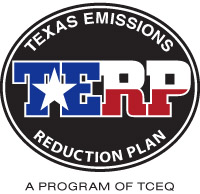
TCEQ's Texas Emissions Reduction Plan (TERP) program continues to be an important tool for reducing emissions from vehicles and equipment operating in Texas, encouraging the use of alternative fuels for transportation in Texas, and supporting new and innovative technologies for reducing emissions from stationary sources. Some of the key program highlights through August 2020 are:
- Since 2001, the Diesel Emissions Reduction Incentive Program has awarded over $1 billion in grants to replace or upgrade more than 19,955 vehicles and pieces of equipment.
- The Texas Clean Fleet Program, implemented in 2009, and the Texas Natural Gas Vehicle Grant Program, implemented in 2011, have together awarded more than $117 million in grants to replace or upgrade 1,892 vehicles with medium- and heavy-duty vehicles powered by compressed natural gas, liquefied petroleum gas, and liquified natural gas.
- The Seaport and Rail Yard Areas Emissions Reduction Program, implemented in 2014, has awarded over $19 million in grants to replace 261 drayage trucks and pieces of cargo-handling equipment operating at seaports and rail yards located in nonattainment areas.
- The Alternative Fueling Facilities Program, implemented in 2011, has awarded over $22 million in grants to establish or upgrade 142 natural gas, alternative fueling, or electric charging facilities in the Texas Clean Transportation Zone.
- Since 2005, more than $44 million in grants has been awarded under the Texas Clean School Bus Program for the retrofit or replacement of 7,794 buses in Texas.
- The New Technology Implementation Grants Program, implemented in 2010, has awarded over $12 million for projects with potential to reduce emissions from stationary sources and projects to store and distribute electricity from renewable sources.
Improvement Levels
Texas has seen improvement in monitored levels of five of the six criteria pollutants established by the Federal Clean Air Act to protect public health and welfare. Design values, which are referenced below, are the statistic used to compare monitored pollutant levels to EPA's National Ambient Air Quality Standards (NAAQS).
- Eight-hour ozone design values in Texas have decreased by 28% over the last 20 years.
- One-hour nitrogen dioxide (NO2) design values in Texas have decreased by 24% and annual NO2 design values in Texas have decreased by 29% over the last 20 years.
- One-hour carbon monoxide (CO) design values in Texas have decreased by 71% and eight-hour CO design values in Texas have decreased by 70% over the last 20 years.
- Lead (Pb) design values in Texas have decreased by 63% over the last 20 years.
- Annual fine particulate matter (PM2.5) design values in Texas have decreased by 24% and 24-hour PM2.5 design values in Texas have decreased by 15% over the last 18 years. Coarse particulate matter (PM10) expected exceedances have decreased by 100% over the last 18 years.
Water Successes
The Texas Water Rights Viewer
The Water Availability Division developed the Texas Water Rights Viewer, which allows the public to quickly and easily access water rights information. The viewer was designed to answer the most common data and information requests TCEQ receives. Through the viewer, a user can find copies of historical water rights adjudication documents and current water rights permits. A user can also find authorized water rights locations such as diversion points and reservoirs, current ownership information, and water use data.
TCEQ Annual Public Drinking Water Conference
Every August since 2003, the Water Supply Division has organized, planned, and implemented the annual Public Drinking Water Conference in Austin. This popular, free conference has attracted over 800 attendees in the past, providing training, workshops, and technical assistance about public water system operations, rule updates, and regulatory programs. Operators can earn continuing education credits for license renewal at this free conference.
In 2019, the conference changed locations to accommodate more attendees and a bigger exhibit space; attendance was over 1,100. Participants included water system operators and managers, exhibitors, laboratory professionals, and state and federal agency personnel. Each year the focus is slightly different, but there are always updates on rules and regulations and pertinent topics such as the revised total coliform rule, lead and copper rule, chloramines, cross-connection control, corrosivity, system optimization, funding, and source water protection.
In 2020, the conference moved to an online format due to the COVID-19 pandemic. There were over 1,100 participants registered to view 27 presentations, earning continuing education credits during the 2-day workshop. The presentations were recorded and are available online.
Texas Integrated Report of Surface Water Quality
The 2018 and 2020 Texas Integrated Report of Surface Water Quality were adopted by the commission and approved by EPA in 2019 and 2020, respectively.
Total Maximum Daily Loads and Implementation Plans
In fiscal 2019 and 2020, 37 Total Maximum Daily Loads (TMDL) and five TMDL Implementation Plans were approved. These activities are intended to improve water quality by reducing pollution.
Other Highlights
New Customer Service Survey
In February 2020, the Legislative Budget Board and Office of the Governor required agencies to measure customer satisfaction with eight new standard survey questions. TCEQ revised its customer survey to replace questions 4 through 11 with the newly required questions and made the new survey available online and in print in both English and Spanish.
Bi-National Collaboration
In 2020, Commissioner Janecka was appointed to the Governmental Advisory Committee to advise the EPA administrator on environmental issues under the United States-Mexico-Canada Agreement (USMCA). Commissioner Emily Lindley represents state priorities to the International Boundary and Water Commission (IBWC). And Chairman Jon Niermann was appointed to represent Texas on the Good Neighbor Environmental Board, a federal committee that advises the president and Congress on environmental and infrastructure issues along the border.
In 2019 and 2020, TCEQ Border Affairs staff in Harlingen, Laredo, and El Paso regularly organized meetings, participated in binational drills, and worked closely with EPA and state and federal counterparts in Mexico to share emergency response equipment, develop contingency plans, and hold simulated training events for first responders on both sides of the border. TCEQ supports binational emergency response planning for sister cities by facilitating communication and partnerships between fire departments in Texas and Mexico. Emergency preparedness and response is one of the Border 2025 program's key priorities.
A Diverse Workforce
In fiscal year 2000, the then-named Texas Natural Resource Conservation Commission was comprised of 54% men and 46% women. As of 2020 those numbers have flipped, with 53.6% of the workforce now women. Also, about 48% of all supervisors are women, which is up from 43% in 2008.
Cooperative Efforts Between TCEQ and EPA
Non-Hazardous Secondary Materials Clarification for Scrap Tires
TCEQ's Scrap Tire Program worked collaboratively with EPA to provide clarification on the Non-Hazardous Secondary Materials rule to allow discarded tires to be used as fuel in cement kilns. This cooperative effort between TCEQ and EPA paved the way for the continued growth in tire-derived fuel and additional cleanup opportunities for discarded scrap tires (see page 9 for more).
Coal Combustion Residuals
TCEQ's Waste Permits Division worked closely with EPA to develop rules for the state's new Coal Combustion Residuals (CCR) Program. With continual changes occurring to the federal CCR rules, TCEQ often met with EPA staff from both headquarters and Region 6 to discuss federal rule changes and the impacts on equivalent state rules. The TCEQ CCR Program is currently under review for approval by EPA and, if approved, will operate in lieu of the federal CCR program in Texas.
Water Quality Division Work with EPA Region 6
TCEQ and EPA Region 6 water quality program managers have continued to work together under the Lean Management System that was developed in fiscal 2018. The Lean system was tailored to focus on the Texas Pollutant Discharge Elimination System (TPDES) permitting program to evaluate and assess work processes to gain efficiencies and reduce waste. The Lean system helped TCEQ and EPA develop an understanding of the process used by each agency and has resulted in a cooperative relationship to help reduce the pending TPDES permit backlog related to EPA objections. It has also helped resolve other programmatic issues that resulted in the delayed issuance of TPDES permits.
In fiscal 2019, TCEQ successfully worked with EPA on the resolution of 19 TPDES permits that received objections from EPA related to cooling water for industrial facilities and 12 TPDES permits that received comments from EPA regarding dissolved solids permit requirements. TCEQ has continued to work with EPA on the resolution of complex technical issues for individual TPDES permits that resulted in EPA objections or comments. The understanding and agreements reached between TCEQ and EPA through the Lean program have helped reduce the number of EPA objections on TPDES permits to seven in fiscal 2019, and three in fiscal 2020.
Outreach to Underserved Businesses
TCEQ continues to manage robust Historically Underutilized Business and Disadvantaged Business Enterprise programs. Agency staff prioritize the programs' goals through procurement and contracting, compliance with statutory and regulatory guidelines, and outreach, having participated in 44 events in fiscal 2020 and continuing at the same pace in fiscal 2021. TCEQ is a top performer among agencies statewide, with more than $5 million in total expenditures; its HUB utilization ranked fifth in fiscal 2019 and second in the fiscal 2020 semi-annual reporting period.
Randy Rogers and Wade Bowen: New TCOT PSA
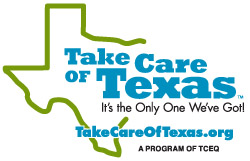
TCEQ's Take Care of Texas (TCOT) program tapped Texas country music mainstays Randy Rogers and Wade Bowen to perform a public service announcement that aired on Texas TV stations and social media platforms.
The native Texans—Rogers of Cleburne and Bowen of Waco—have racked up countless career milestones individually. Together, the pair shares two decades of friendship and collaboration. On May 8, 2020, they released their latest studio album, a long-awaited follow up to their critically acclaimed collaborative debut. In June 2020, their TCOT PSA began airing on platforms across the state of Texas.
In conjunction with the PSA, Texans were asked to join Rogers and Bowen in taking the pledge to Take Care of Texas. In just a little over two months, the campaign garnered pledges from 2,099 Texans, and the video was viewed more than 75,000 times across social media platforms. During the time the PSA was promoted on social media, the TCOT accounts saw more than 2.4 million impressions and 43,000 engagements.
Take Care of Texas is a statewide campaign from TCEQ that provides helpful information on Texas' successes in environmental protection and encourages all Texans to help keep our air and water clean, conserve water and energy, and reduce waste.
Administrative
In fiscal 2020, TCEQ successfully implemented the first phase in our transition to the statewide Centralized Accounting and Payroll/Personnel System (CAPPS), replacing legacy payroll, timekeeping, and personnel systems. In adopting CAPPS, TCEQ expects to increase efficiency, minimize data errors, and provide real-time, accurate personnel and payroll data.

